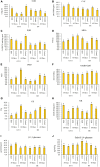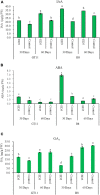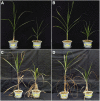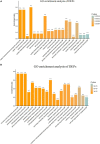Differential Protein Expression Analysis of Two Sugarcane Varieties in Response to Diazotrophic Plant Growth-Promoting Endophyte Enterobacter roggenkampii ED5
- PMID: 34887881
- PMCID: PMC8649694
- DOI: 10.3389/fpls.2021.727741
Differential Protein Expression Analysis of Two Sugarcane Varieties in Response to Diazotrophic Plant Growth-Promoting Endophyte Enterobacter roggenkampii ED5
Abstract
Plant endophytic bacteria have many vital roles in plant growth promotion (PGP), such as nitrogen (N) fixation and resistance to biotic and abiotic stresses. In this study, the seedlings of sugarcane varieties B8 (requires a low concentration of nitrogen for growth) and GT11 (requires a high concentration of nitrogen for growth) were inoculated with endophytic diazotroph Enterobacter roggenkampii ED5, which exhibits multiple PGP traits, isolated from sugarcane roots. The results showed that the inoculation with E. roggenkampii ED5 promoted the growth of plant significantly in both sugarcane varieties. 15N detection at 60 days post-inoculation proved that the inoculation with strain ED5 increased the total nitrogen concentration in the leaf and root than control in both sugarcane varieties, which was higher in B8. Biochemical parameters and phytohormones in leaf were analyzed at 30 and 60 days after the inoculation. The results showed that the inoculation with E. roggenkampii ED5 improved the activities of superoxide dismutase (SOD), catalase (CAT), NADH-glutamate dehydrogenase (NADH-GDH), glutamine synthetase (GS), and endo-β-1,4-glucanase, and the contents of proline and indole acetic acid (IAA) in leaf, and it was generally more significant in B8 than in GT11. Tandem Mass Tags (TMT) labeling and liquid chromatography-tandem mass spectrometry (LC-MS/MS) were used to perform comparative proteomic analysis in the sugarcane leaves at 30 days after inoculation with strain ED5. A total of 27,508 proteins were detected, and 378 differentially expressed proteins (DEPs) were found in the treated sugarcane variety B8 (BE) as compared to control (BC), of which 244 were upregulated and 134 were downregulated. In contrast, a total of 177 DEPs were identified in the treated sugarcane variety GT11 (GE) as compared to control (GC), of which 103 were upregulated and 74 were downregulated. The DEPs were associated with nitrogen metabolism, photosynthesis, starch, sucrose metabolism, response to oxidative stress, hydrolase activity, oxidative phosphorylation, glutathione metabolism, phenylpropanoid metabolic process, and response to stresses in Gene Ontology (GO) and Kyoto Encyclopedia of Genes and Genomes (KEGG) database. To the best of our knowledge, this is the first proteomic approach to investigate the molecular basis of the interaction between N-fixing endophytic strain E. roggenkampii ED5 and sugarcane.
Keywords: Enterobacter roggenkampii ED5; N-fixation; PGP; TMT; endophyte; proteome; sugarcane.
Copyright © 2021 Guo, Li, Singh, Singh, Sharma, Verma, Qin, Khan, Lu, Malviya, Song, Xing and Li.
Conflict of interest statement
The authors declare that the research was conducted in the absence of any commercial or financial relationships that could be construed as a potential conflict of interest.
Figures







References
-
- Alberton D., Valdameri G., Moure V. R., Monteiro R. A., Pedrosa F. D. O., Müller-Santos M., et al. (2020). What did we learn from plant growth-promoting rhizobacteria (PGPR)-grass associations studies through proteomic and metabolomic approaches? Front. Sustain. Food Syst. 4:607343. 10.3389/fsufs.2020.607343 - DOI
-
- Antunes J. E. L., Freitas A. D. S., Oliveira L., Delyra M., Fonseca M. A., et al. (2019). Sugarcane inoculated with endophytic diazotrophic bacteria: effects on yield, biological nitrogen fixation and industrial characteristics. Anais Acad. Brasil. Ciências 91:3765201920180990. 10.1590/0001-3765201920180990 - DOI - PubMed
-
- Asghari B., Khademian R., Sedaghati B. (2020). Plant growth promoting rhizobacteria (PGPR) confer drought resistance and stimulate biosynthesis of secondary metabolites in pennyroyal (Mentha pulegium L.) under water shortage condition. Sci. Horticul. 263:109132. 10.1016/j.scienta.2019.109132 - DOI
-
- Basanta M. V., Dourado-Neto D., Reichardt K., Bacchi O. O. S., Oliveira J. C. M., Trivelin P. C. O., et al. (2003). Management effects on nitrogen recovery in a sugarcane crop grown in Brazil. Geoderma 116 235–248. 10.1016/s0016-7061(03)00103-4 - DOI
LinkOut - more resources
Full Text Sources
Miscellaneous

